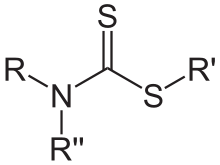Dithiocarbamate
A dithiocarbamate is a functional group in organic chemistry. It is the analog of a carbamate in which both oxygen atoms are replaced by sulfur atoms (when only 1 oxygen is replaced the result is thiocarbamate).

A common example is sodium diethyldithiocarbamate. Dithiocarbamates and their derivatives are widely used in the vulcanization of rubber.[1]
Formation
Many primary and secondary amines react with carbon disulfide and sodium hydroxide to form dithiocarbamate salts:[2]
- R2NH + CS2 + NaOH → R2NCS2−Na+ + H2O
Ammonia reacts with CS2 similarly:
- 2 NH3 + CS2 → H2NCS2−NH4+
Dithiocarbamate salts are pale colored solids that are soluble in water and polar organic solvents.
Reactions
Dithiocarbamates are readily S-alkylated. Thus, methyl dimethyldithiocarbamate can be prepared by methylation of the dithiocarbamate:[3]
- (CH3)2NCS2Na + (CH3O)2SO2 → (CH3)2NC(S)SCH3 + Na[CH3OSO3]
Oxidation of dithiocarbamates gives the thiuram disulfide:
- 2 R2NCS2− → [R2NC(S)S]2 + 2e−
Thiuram disulfides react with Grignard reagents to give esters of dithiocarbamic acid:[4]
- [R2NC(S)S]2 + R'MgX → R2NC(S)SR' + R2NCS2MgX
Structure and bonding
Dithiocarbamates is described by invoking resonance structures that emphasize the pi-donor properties of the amine group. This bonding arrangement is indicated by a short C–N distance and the coplanarity of the NCS2 core as well as the atoms attached to N.[5]

Because of the pi-donation from nitrogen, dithiocarbamates are more basic than structurally related anions such as dithiocarboxylates and xanthates. Consequently, they tend to bind as bidentate ligands. Another consequence of the C–N multiple bonding is that rotation about that bond is subject to a high barrier.
Applications
Zinc dithiocarbamates are used to modify the crosslinking of certain polyolefins with sulfur, a process called vulcanization. They are used as ligands for chelating metals.[6]
2Improved.png)
Dithiocarbamates specifically ethylene bisdithiocarbamates (EBDCs), in the form of complexes with manganese (maneb), zinc (zineb) or a combination of manganese and zinc (mancozeb), have been used extensively as fungicides in agriculture from the 1940s.[7]

See also
References
- Engels, Hans-Wilhelm; et al. "Rubber, 4. Chemicals and Additives". Ullmann's Encyclopedia of Industrial Chemistry. Weinheim: Wiley-VCH. doi:10.1002/14356007.a23_365.pub2.
- Rüdiger Schubart (2000). "Dithiocarbamic Acid and Derivatives". Ullmann's Encyclopedia of Industrial Chemistry. Weinheim: Wiley-VCH. doi:10.1002/14356007.a09_001.
- A. D. Ainley, W. H. Davies, H. Gudgeon, J. C. Harland and W. A. Sexton (1944). "The Constitution of the So-Called Carbothialdines and the Preparation of Some Homologous Compounds". J. Chem. Soc.: 147–152. doi:10.1039/JR9440000147.CS1 maint: uses authors parameter (link)
- John R. Grunwell (1970). "Reaction of Grignard Reagents with Tetramethylthiuram Disulfide [yielding dithiocarbamates]". J. Org. Chem. 35: 1500–1501. doi:10.1021/jo00830a052.
- Coucouvanis, Dimitri (1979). "The chemistry of the dithioacid and 1,1-dithiolate complexes, 1968–1977". Prog. Inorg. Chem. 26: 301–469. doi:10.1002/9780470166277.ch5.
- Greenwood, Norman N.; Earnshaw, Alan (1997). Chemistry of the Elements (2nd ed.). Butterworth-Heinemann. ISBN 978-0-08-037941-8.
- "A Short History of Fungicides". The American Phytopathological Society. Archived from the original on 16 April 2016. Retrieved 10 May 2016.
- Theo Mang, Jürgen Braun, Wilfried Dresel, Jürgen Omeis (2011). "Lubricants, 2. Components". Ullmanns Encyclopedia of Industrial Chemistry. Wiley-VCH. doi:10.1002/14356007.o15_o04.CS1 maint: uses authors parameter (link)